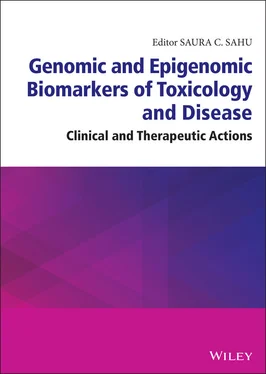Genomic and Epigenomic Biomarkers of Toxicology and Disease
Здесь есть возможность читать онлайн «Genomic and Epigenomic Biomarkers of Toxicology and Disease» — ознакомительный отрывок электронной книги совершенно бесплатно, а после прочтения отрывка купить полную версию. В некоторых случаях можно слушать аудио, скачать через торрент в формате fb2 и присутствует краткое содержание. Жанр: unrecognised, на английском языке. Описание произведения, (предисловие) а так же отзывы посетителей доступны на портале библиотеки ЛибКат.
- Название:Genomic and Epigenomic Biomarkers of Toxicology and Disease
- Автор:
- Жанр:
- Год:неизвестен
- ISBN:нет данных
- Рейтинг книги:4 / 5. Голосов: 1
-
Избранное:Добавить в избранное
- Отзывы:
-
Ваша оценка:
- 80
- 1
- 2
- 3
- 4
- 5
Genomic and Epigenomic Biomarkers of Toxicology and Disease: краткое содержание, описание и аннотация
Предлагаем к чтению аннотацию, описание, краткое содержание или предисловие (зависит от того, что написал сам автор книги «Genomic and Epigenomic Biomarkers of Toxicology and Disease»). Если вы не нашли необходимую информацию о книге — напишите в комментариях, мы постараемся отыскать её.
The latest developments in biomarker research applicable to toxicology and medicine Genomic and Epigenomic Biomarkers of Toxicology and Disease: Clinical and Therapeutic Actions
Genomic and Epigenomic Biomarkers of Toxicology and Disease: Clinical and Therapeutic Actions
Genomic and Epigenomic Biomarkers of Toxicology and Disease — читать онлайн ознакомительный отрывок
Ниже представлен текст книги, разбитый по страницам. Система сохранения места последней прочитанной страницы, позволяет с удобством читать онлайн бесплатно книгу «Genomic and Epigenomic Biomarkers of Toxicology and Disease», без необходимости каждый раз заново искать на чём Вы остановились. Поставьте закладку, и сможете в любой момент перейти на страницу, на которой закончили чтение.
Интервал:
Закладка:
Therefore the decision whether to quantify miRNA biomarkers from unfractionated samples or from isolated EVs may depend on context and on intended use. Additionally, questions remain as to which one is more reliable in biomarker measurements; and some reports suggest that this may depend on the specific human disease. A disease-specific alteration in exosome release and clearance, or the administration of therapeutics that alter the volume of blood, can skew the yield (Buschmann et al. 2018; Hanna et al. 2019). The isolation of miRNAs from unfractionated biofluid samples should capture both miRNAs that originate from passive leakage into the sampled matrix and miRNAs that come from actively released membrane-bound vesicles lysed through the isolation procedure. This isolation avoids major drawbacks of vesicle purification, which lowers RNA yield and integrity and can result is greater experimental variability. Another challenge is that, depending on the method used, different populations of EVs are isolated; and this produces only partially overlapping RNA profiles (Buschmann et al. 2018). Recently, a comprehensive analysis of published results compared the utility of miRNAs isolated from EVs to the utitliy of those isolated from unfractionated whole serum or plasma for specific biomarker use (Nik Mohamed Kamal and Shahidan 2019). Twenty of the thirty-two studies cited suggested that EV-derived miRNAs may be preferable for the intended use examined. A commonly reported reason was the potential for increased stability that might be derived from being encapsulated in a vesicle. But it is also important to note that these intended uses varied, and included both in vitro and in vivo biomarker development for heart failure, chronic pain, septic shock, non-alcoholic fatty liver disease, immunization, and many types of cancer. So, while a slight majority of studies recommended vesicle fraction miRNA for biomarker measurement, specific research needs to be performed to provide the appropriate conditions and context of use.
MicroRNAs as Bioindicators of Toxicity and Disease
Much miRNA biomarker research has been focused on the early detection of drug-induced liver injury (DILI), a major roadblock in drug development. Alanine aminotransferase, aspartate aminotransferase, alkaline phosphatase, and total bilirubin are the currently approved DILI biomarkers in clinical practice (Robles-Diaz et al. 2016). These biomarkers are not specific to hepatotoxicity, as they increase in almost all abnormal liver conditions. Furthermore, they lack sensitivity, as they appear once liver damage has developed, and consequently have limited use for predicting potential liver injury at an early stage. For this reason, circulating miRNAs are being investigated for the monitoring of drug-induced tissue injury (tissue degeneration and necrosis) in cases where highly abundant tissue-specific miRNAs are passively released after cell injury. In incidences of DILI, studies have demonstrated that miR-122 presence in blood correlates tightly with pathological indications and clinical chemistries (i.e., ALT, AST) of liver degeneration (Krauskopf et al. 2015; Song et al. 2016; Wang et al. 2009). In combination with the liver injury biomarkers cytokeratin-18 and glutamate dehydrogenase, miR-122 outperformed individual biomarkers and had a higher than 0.92 correlation with alanine aminotransferase (ALT) in a validation cohort of individuals with acetominophen overdose (Llewellyn et al. 2021). In pre-clinical settings, miR-122 did mildly improve the diagnosis of DILI (4% increase in predictive accuracy using a multiparameter approach) and was highly correlated with necrosis, vacuolization, and hepatocellular hypertrophy (Sharapova et al. 2016), which indicated its usefulness as a leakage biomarker. However, the use of miR-122 has been hampered by a notably high baseline variability in human samples (> 100-fold interval; Vogt et al. 2019). This was likely due to differences in ethnic backgrounds (Church et al. 2019), undiagnosed states such as milder pathologies of non-alcoholic fatty liver disease (Cermelli et al. 2011), and short circulatory half-life (Thulin et al. 2017).
A review by Harrill et al. (2016) comparing biofluid-based miRNAs (e.g., blood, urine) to traditional biomarkers of tissue toxicity found that miRNA often outperformed conventional biomarkers in terms of a better correlation with tissue injury and earlier detection. Recent studies in rats have identified miRNA biomarkers specific to different stages (early, middle, late) and types (hepatocellular injury, cholestasis, steatosis) of DILI (Kagawa et al. 2018) and to different lesion sites in the nephron due to nephrotoxicants (Chorley et al. 2021b). Further study is needed to determine whether these biomarkers are translatable for the detection of specific organ injuries in humans. Potential miRNA biomarker candidates for the early detection of DILI were identified by examining hepatic miRNA expression in ketoconazole-treated rats with miRNA-sequencing (Li et al. 2021). The investigators then looked for the candidates evolutionarily conserved between rats and humans in the culture medium of ketoconazole-treated HepaRG cells with quantitative polymerase chain reaction (PCR) and identified miR-34a-5p, miR-331-3p, and miR-15b-3p as translational biomarker candidates for the early detection of ketoconazole-induced liver injury.
In addition to liver and kidney injury, circulating miRNAs are being investigated as mechanistic biomarkers of diseases such as cancer (Dutta et al. 2019; Jin et al. 2019; Lin et al. 2019; Pascut et al. 2019; Wang et al. 2018), cardiovascular disease (Zhou et al. 2018), metabolic syndrome (Huang et al. 2018), neurodegenerative disease (Juzwik et al. 2019; Sharma and Lu 2018), and chronic obstructive pulmonary disease (COPD) (Finicelli et al. 2020), all diseases whose etiology can include environmental toxicant exposure. Several recent reviews examine the dysregulation of miRNAs by environmental contaminants related to human health (Balasubramanian et al. 2020; Harrill et al. 2016; Qiao et al. 2019; Sollome et al. 2016; Tumolo et al. 2020; Wallace et al. 2020). Vrijens et al. (2015) summarized some of the miRNAs that respond to environmental exposure and their roles in human disease. The current knowledge linking cancer and neurodegenerative diseases to dysregulation of miRNAs after pesticide exposure was reviewed by Costa et al. (2020). A comprehensive literature review by Sima et al. 2011 (twenty-seven studies between 2012 and 2020) focused on miRNA expression in humans exposed to various air pollutants. Because air pollution is a factor in the development of lung cancer, they reported miRNAs commonly deregulated by both conditions, identifying twenty-five miRNAs that could serve as biomarkers of exposure to harmful pollutants that potentially contribute to lung cancer development. Several miRNAs were deregulated in multiple studies and may therefore be the most promising candidates: miRs-222, -21, -126-3p, -155 and -425.
Table 2.1compiles the literature evidence from these and other studies in humans. The heterogeneity in sample types, methods of analysis, and study designs makes it difficult to compare the studies directly. Altered levels of some miRNAs are observed in several studies with the same pollutant category and sample type, but with different direction of expression (e.g., particulate matter (PM) exposure altered miRs-21-5p, -223-3p and -146; Bollati et al. 2010; Louwies et al. 2016; Motta et al. 2013; Rodosthenous et al. 2016). Additional miRNAs dysregulated by air pollution in more than one study included let-7g, miR-126 and miR-132. miR-146 was downregulated in both bronchial epithelial cells and induced sputum of smokers. miRs-21, -126 and -155 were dysregulated in both urine and blood–serum with arsenic exposure. Overall, miR-21, which is highly expressed and ubiquitous across most cell types, was most often reported as dysregulated across multiple categories of environmental contaminants. miR-21 plays a role in inflammation and is elevated in many different disease states, which suggests that it is commonly upregulated in a stress environment and is not specific to any one disease or exposure, as is probably the case for other ubiquitously expressed miRNA (Jenike and Halushka 2021).
Читать дальшеИнтервал:
Закладка:
Похожие книги на «Genomic and Epigenomic Biomarkers of Toxicology and Disease»
Представляем Вашему вниманию похожие книги на «Genomic and Epigenomic Biomarkers of Toxicology and Disease» списком для выбора. Мы отобрали схожую по названию и смыслу литературу в надежде предоставить читателям больше вариантов отыскать новые, интересные, ещё непрочитанные произведения.
Обсуждение, отзывы о книге «Genomic and Epigenomic Biomarkers of Toxicology and Disease» и просто собственные мнения читателей. Оставьте ваши комментарии, напишите, что Вы думаете о произведении, его смысле или главных героях. Укажите что конкретно понравилось, а что нет, и почему Вы так считаете.












![John Bruce - The Lettsomian Lectures on Diseases and Disorders of the Heart and Arteries in Middle and Advanced Life [1900-1901]](/books/749387/john-bruce-the-lettsomian-lectures-on-diseases-and-disorders-of-the-heart-and-arteries-in-middle-and-advanced-life-1900-1901-thumb.webp)